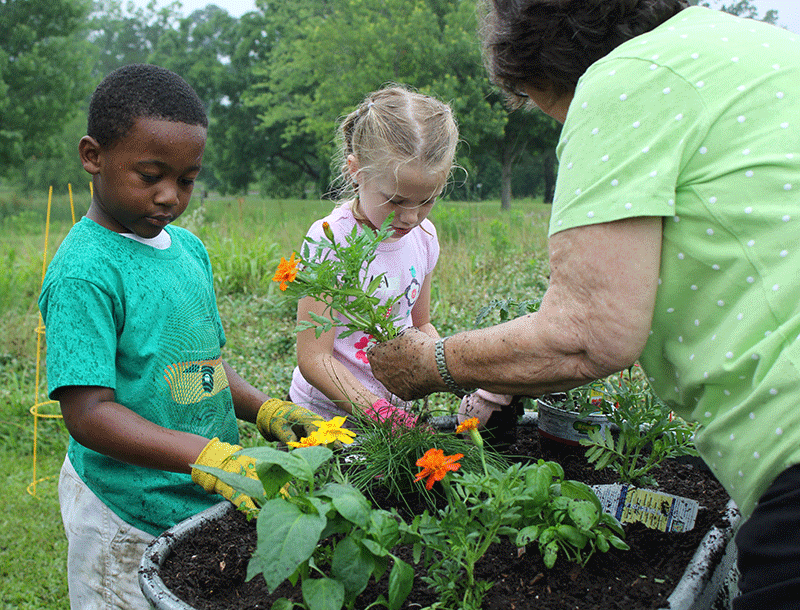
Photo by L.A. Jackson
By Katie Jackson
The spring awakening has begun and, as our plants wake up from their long winter naps, so does our gardening energy. Why not use some of that energy to make your landscape and food gardens even more appealing?
One exceptional way to apply your gardening energy is to focus your efforts on improving your curb appeal, that term realtors use to describe a front yard that draws in prospective buyers or simply makes your yard a jewel of the neighborhood.
Whether you’re putting a house on the market or simply want to improve the value and looks of your home, investing in your landscape is money well spent. According to real estate experts, an attractive landscape increases a home’s value by up to 15 percent, and money spent on landscaping is estimated to pay for itself five to 10 times over when a home sells. Plus, improving your home’s landscape can make it even more enjoyable for you and your family and also helps address functional issues, such as drainage or erosion problems.
An easy and inexpensive way to immediately increase your curb appeal is to adorn your front steps or porch with pretty plantfilled containers. Or use flowering perennials or annuals to fill window boxes, flowerbeds or line walkways.
Ornamental grasses and groundcovers can also be used to fill empty spots in flowerbeds or cover bare or eroded spots in the yard. And many of those ornamental grasses also make stunning accent plants in the yard or in containers.
A lush vining plant can be the perfect quick-fix option to camouflage a less-than-attractive mailbox, pump house, tool shed or other structure in the yard. Or, if you have a bare outside wall that needs some adornment, train a vine on a trellis or other standalone structure in front of the wall for an almost instant solution.
If you’re willing to dig a little deeper in your pocket and soil to add long-term beauty to your yard, trees and shrubs are the way to go. Trees reportedly offer the greatest return on investment with shrubs being a close second, and a single handsome tree or shrub can instantly fill a bare spot in the landscape, or plant several in strategic spots throughout the yard as accent plants.
Not sure how to get started upgrading your curb appeal? The Alabama Smart Yards publication (available through your local Cooperative Extension office or at www.aces.edu/pubs/docs/A/ANR-1359/ANR-1359.pdf) that I oft en mention in this column has a chapter on landscape planning, and local realtors and appraisers often also have guidelines for improving curb appeal. Or just search the web for ideas.
One person’s weed is another’s super food
For example, “super” or “powerhouse” foods are all the rage and include okra, greens (the very hip kale and a new “Peppermint Stick” chard among them) as well as beets, which can be found in a lovely array of colors. But this category of foods also includes plants that may already be in our yards—dandelion greens, nettle and purslane among them. Apparently one person’s weed is another person’s super food.
If you want a “super” berry, consider planting goji berries (also known as wolfberries) or one of the new cultivars of blueberries that come in shades of lemonade pink and peach sorbet. For something especially unusual there is Haskap (also called honeyberry), a member of the honeysuckle family that has elongated blueberry-like fruits that reportedly taste like a cross between blueberries and raspberries.
Tomato lovers may want to try “Indigo” snack-sized tomatoes that come in purple (almost black), gold and indigo and are touted to have exceptional flavor. Or get two crops for the price of one with a pomato, which is a cherry tomato grafted onto a potato plant. And there are even “fruit salad trees,” which are grafted stone fruit, apple and citrus trees that bear up to six different fruits of the same family all on the same tree.
Looking for a small bite? Try “Petipikle,” a new petite pickling cucumber that can be used in the garden or as a container plant. Want an interesting new herb? ‘Zesty Fanfare’ is a Thai basil with long flower spikes that is said to be as beautiful as it is flavorful.
These are just a few of the many interesting fruit and vegetable options to try. Find more online or ask a local plant retailer for suggestions. A word of caution, though: Try these new options in limited numbers to make sure you really like them and they perform well before you forgo those tried-and-true favorites.
Whether you decide to focus your spring energy on food crops or on your landscape—or both—just go out and enjoy the weather!
March Tips
Transplant shrubs and trees early in March.
Remove winter mulch from garden beds gradually as the plants show signs of new growth.
Divide and transplant summer-blooming perennials and fertilize established ones as soon as new growth appears.
Add any amendments (composted or processed manure, peat moss, compost, etc.) into your garden soil.
Plant green peas, snow peas, asparagus, horseradish and artichokes early in the month.
Plant eggplant, Brussels sprouts, cauliflower, celery, leeks, onions, early potatoes and radish seeds.
Plant strawberries, blueberries, grapes and fruit trees.
Sow seeds for tomatoes, lettuce, carrots and other spring vegetables.
Prune or pinch back house plants that are getting leggy and begin fertilizing them with a diluted solution of plant food.
Begin weeding garden or flowerbeds as soon as weeds emerge.
Clean out birdhouses and feeders.




